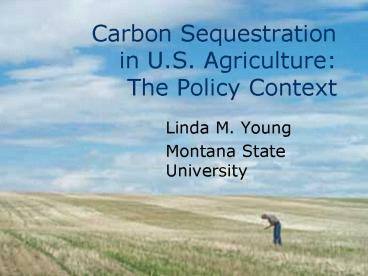Carbon Sequestration in U.S. Agriculture: The Policy Context - PowerPoint PPT Presentation
1 / 17
Title:
Carbon Sequestration in U.S. Agriculture: The Policy Context
Description:
GHG emissions cause a global externality. Countries/businesses lack ... Senators McCain and Leiberman. Bill in Congress. U.S. State Policies. Many state actions ... – PowerPoint PPT presentation
Number of Views:41
Avg rating:3.0/5.0
Title: Carbon Sequestration in U.S. Agriculture: The Policy Context
1
Carbon Sequestration in U.S. Agriculture The
Policy Context
- Linda M. Young
- Montana State University
2
Are there incentives?
- Agricultural soils a potential sink for carbon
- Changing management practices (no-till)
- Incentives for agricultural sequestration of
carbon - Through the market?
- Through government programs?
3
International Policies
- Concern over carbon dioxide levels
- Atmosphere public good
- GHG emissions cause a global externality
- Countries/businesses lack incentives to act alone
- 1988 Inter governmental Panel established
4
United Nations FCCC
- 175 countries signed
- Nations committed to
- GHG mitigation and adaptation programs
- inventory GHG emissions
- Annex 1 parties ? emissions to 1990 levels by
2000 (non-binding)
5
Kyoto Protocol
Kyoto Protocol
- Negotiations concluded 1997
- Close to ratification
- 101 countries, 43.9 emissions
- -Russia?
- U.S. and Australia UNFCCC
- Key Annex 1 parties reduce emissions to 95 of
1990 levels - Policies to reduce emissions
6
Forestry and Agriculture Problematic
- Verification of carbon sequestered difficult
- Guidelines agreed 2001 Marrakesh accords
- Revegetation, management of crop and grazing
lands - Credit for carbon sequestered over 1990 levels
7
Flexibility Provisions
- Joint implementation
- Clean development mechanism
- Not agricultural sequestration
- Credit trading
- Only between ratified parties
- U.S., Australia cannot participate
- Market fractured ratified and not
- Demand weak for non-ratified credits
8
U.S. Response to Climate Change, Kyoto
- Bush disagrees with science and responsibilities
- Bush Climate Action Plan
- Reduce GHG intensity 18, 10 years
- From 183 MTCE ( million) to 151 MTCE by 2012
- Voluntary actions
- Incentive based measures
9
Criticism of U.S. Plan
- Total emissions increase
- In 2012 emissions 130 1990 levels
- If KP ratified, 93 of 1990
- Pew Center
- intensity decrease on trend
- Changing technology
Bush Plan
130
1990 Level
100
Kyoto Protocol
93
10
Administrations Plan
- Some firms may act voluntarily
- Others incentives not strong enough
- Examplefailure of UNFCCC goal
- Bush plan
- Climate change not a serious problem
- Not requiring international cooperation
11
Current U.S. Policy
- Departure from past approaches
- Acid rain program
- Emissions limits and trading
- Successful, least cost program
- Senators McCain and Leiberman
- Bill in Congress
12
U.S. State Policies
- Many state actions
- Their role?
- State programs as prototypes
- National involvement/international agreement
- Businesses facing patchwork of registries and
incentives
13
The Market for Carbon Credits
- Example energy company emit GHG
- Purchase offset from renewable energy company
- Why trade?
- Binding limits
- Not emissions caps
- expectations
- Environmental good citizen
- Learn by doing
14
Market for Carbon Sequestration
- Carbon market determine demand for agricultural
sequestration - Limited information, pilot purchases
- EPA registry (not trades) of 369 sequestration
projects, 2 involved agriculture - Transactions costs high
- Poorly defined terms, detailed contracts
- Industry wants regulatory body
15
U.S. Government Agricultural Programs
- Bush administration-receptive
- Directed Secretary of Agriculture
- 2002 Farm bill- increased funding
- Congressional support high
- 25 bills introduced carbon sequestration
- Programs are voluntary
- Ag. Seq. produces environmental benefits
- Programs likely compatible with URAA Cont.
pressure to support farm income
16
How much can agriculture sequester? (in mmtce)
1982-97 17 Management changes
(4.5) CRP 13.2 mm hectraces
Possible 47 No till all cropped farmland
Possible 20 Summer fallow eliminated
Total potential 83 All practices
Source Sperow, Eve, Paustian
17
Conclusions
- Market development hindered by non-ratification
- Demand for U.S. carbon credits weak with
implementation of KP - Little impetus overcome verification, monitoring
challenges - Government ag programs likely source of demand































